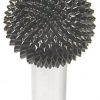Magnets and Matter; Arts and Science
We tend to think of magnetism in relation to solid matter. From the neodymium varieties we deal with, to the largest galaxies, magnetic fields are usually tethered to the tangible realm. However, as our following examples demonstrate, there is plenty to discover in liquids and gases. Furthermore, it is not only the scientific community that benefits from magnetism's relationship with various matter. There are plenty of magnetic forays in the art world as well!
Liquid Magnets and Visual Art
Andrew Hall is a photographer who captures the behavior of liquids and gases. The final products of his endeavors can only be described as masterpieces. To create these works of art, he utilizes additional elements, such as sound waves and magnetic fields that result in magical photographs which boast stunning colors and designs. How does he do it? Let’s take a closer look.
Although he occasionally uses basic water as the liquid component in his creations, he sometimes turns to ferrofluid. As described in The Week, this special water or organic solvent is made up of iron-containing particles and its shape can be manipulated by the presence of magnets or a magnetic field.
Hall then fills a container, about three millimeters deep, with the ferrofluid matter and places it overtop a magnetic field before adding color in the form of paint or ink. As he moves a magnet closer then farther away from the substance, the liquid changes shape. The closer the magnet gets, its shape is sharper and more contained. When moved farther away, it allows the ferrofluid to expand, creating softer bursts of color.
The Science of Magnetic Gases
Hall has only been exploring this kind of photography for about the past four years but the possibilities for his future projects are endless. While this incredible collection focuses on liquids and their behavior, scientists are beginning to observe the presence of magnetism in gases.
In 2009, MIT scientists discovered ferromagnetic behavior in atomic gas, similar to a magnet made from nickel or iron. Over the course of several experiments, clouds composed of ultra-cold lithium became larger and then immediately shrunk. When released from the trap in which the experiments were being conducted, they expanded at a faster rate. In short, this gas composed of elementary particles, called fermions, does not not require a crystalline structure to be ferromagnetic.
Although those involved in these experiments agreed the results were promising, there is more research to be done. Their findings are exciting though when it comes to future projects, both scientific and artistic in nature. In the meantime, you can stay up to date on such developments by following along with our blog.

